What is it?
Ampelous plants, or ampels, are representatives of flora that are grown in hanging containers. The term comes from the German expression “die Ampel”, which is traditionally translated as “hanging vase of flowers”.
Ampels can refer to different decorative types, but mainly they are climbing or creeping herbaceous or shrubby plants. They are grown for the purpose of decorating or zoning rooms, house and garden plots.
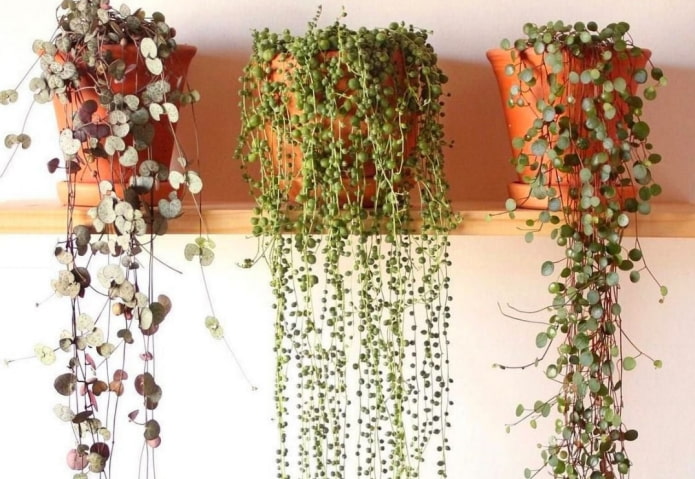
Catalog of the most popular plants
Ampelous indoor plants
There are many types of ampelous indoor plants. They are used to decorate various openings and walls, as well as to zone rooms. Most of them look equally good on horizontal supports and in hanging pots.
Scindapsus painted
Scindapsus painted is an evergreen unpretentious liana from the Araceae family, whose homeland is considered to be the humid tropical forests of Southeast Asia. In the natural environment, it is a plant climbing along trunks or creeping along the ground, using aerial roots as support.
It has large dark green leaves covered with asymmetrical spots. In temperate climates, it is grown indoors, preferring moist soils and partial shade.
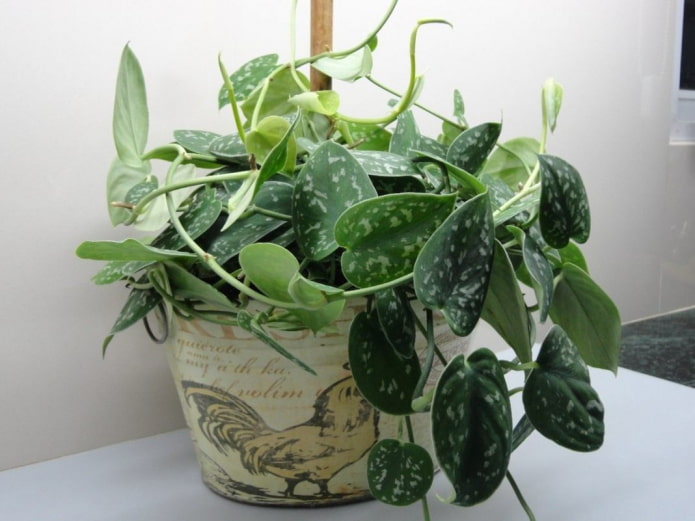
Ipomoea batata, or Sweet potato
Ipomoea batata is a climbing vine native to South America. It has been known in agriculture for over 2,000 years and is cultivated primarily for its edible sweet tubers. Young leaves of the plant are also eaten.
Ipomoea is also grown as an ampelous variety, since its curly creeping shoots are very beautiful. They look good in a planter or pot.

Ficus pumila, or creeping fig
Ficus pumila belongs to the Mulberry family and comes from the humid tropics of South Asia. It is a close relative of the rubber plant, but unlike it, it has very long creeping stems.
It can also curl upward with the help of aerial roots, beautifully braiding vertical supports. The stem of the plant is covered with dark green heart-shaped leaves, during the flowering period it is covered with small nondescript buds and soon red berries.
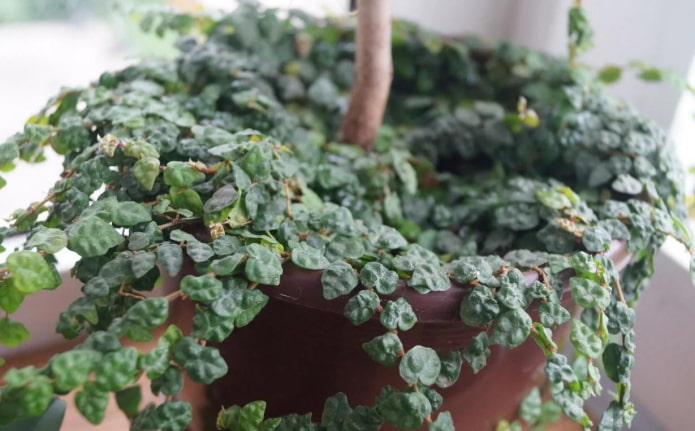
Cissus
Cissus is a large genus, represented by more than 300 species of tropical plants, which are very different in appearance. However, these are mainly climbing vines that grow quickly and climb up vertical supports. They have powerful stems and large variegated leaves. They are easy to care for, so they are popular in indoor floriculture.
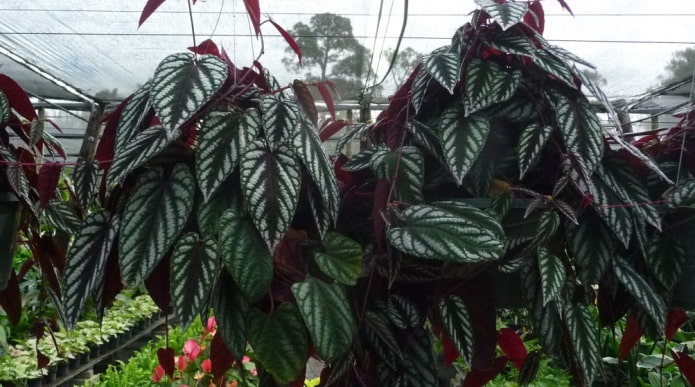
Nephrolepis exaltata, or sword-shaped fern
It is the most common type of fern and comes from forests and swamps in Central and South America. It is an evergreen plant with very large drooping leaves, the length of which averages from 40 to 95 cm, and in rare cases – up to 1.5 meters. Often grown indoors due to their low maintenance, they look good in a pot or flowerpot.
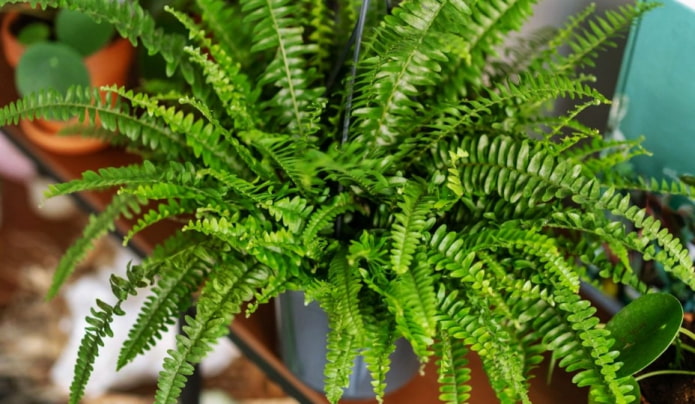
Maidenhair Fern
Maidenhair ferns, also known as curly ferns, are native to South America. Their natural habitat includes forests and rock crevices, shady banks of rivers and streams. They have picturesque fan-shaped leaf segments, usually grouped on wiry black stems. Adiantums are hardy only in USDA zones 10-11, and are grown indoors in the temperate zone.
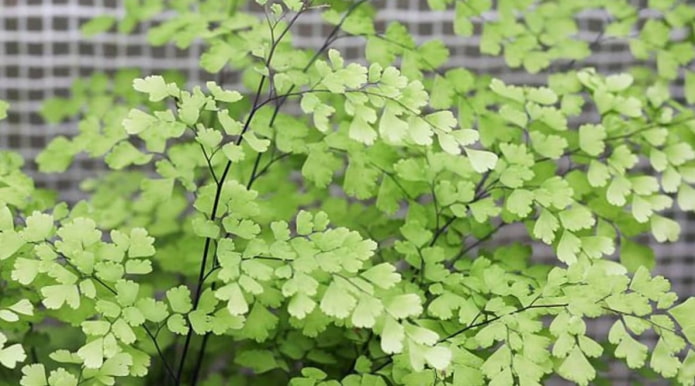
Pelleya rotundifolia
It belongs to the class of ferns and has characteristic spectacular fronds. In the wild, it is found in the tropics and subtropics throughout the world, but is also widely cultivated in the temperate zone in indoor conditions. The plant’s popularity is due to its beautiful dense foliage, small size and ease of cultivation.
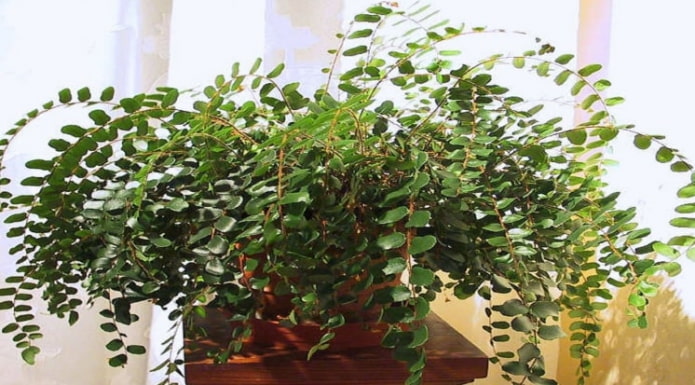
Begonia convolvulus
It belongs to the selection varieties of the genus Begonia of the Begoniaceae family. It has very beautiful spiral leaves and attractive flowers. It is unpretentious and grows very actively in indoor conditions, quickly twining around prepared supports.
As a rule, it is grown at home to decorate balconies, various openings and walls, which it completely covers. They look good in a flowerpot or pot.
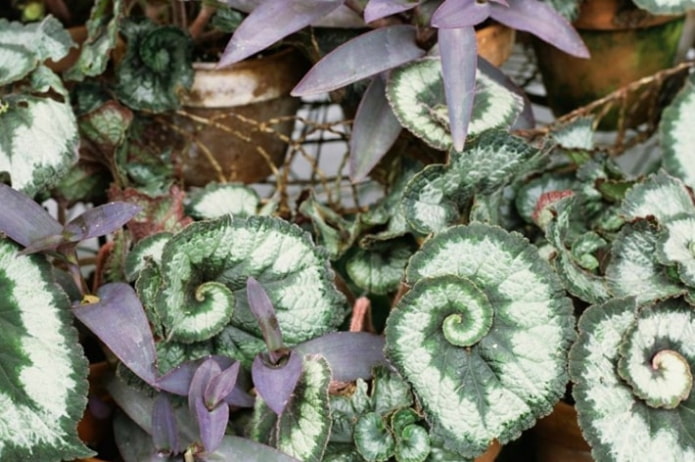
Saxifrage scaly-leaved
It lives in rock crevices in Japan, China, and South Korea. However, it is widely cultivated throughout the world due to its unusual appearance. The plant has a lush rosette of large, slightly drooping leaves, from which multiple penetrating shoots extend. These are very thin and long stems with small leaves and flowers that are easy to grow at home.
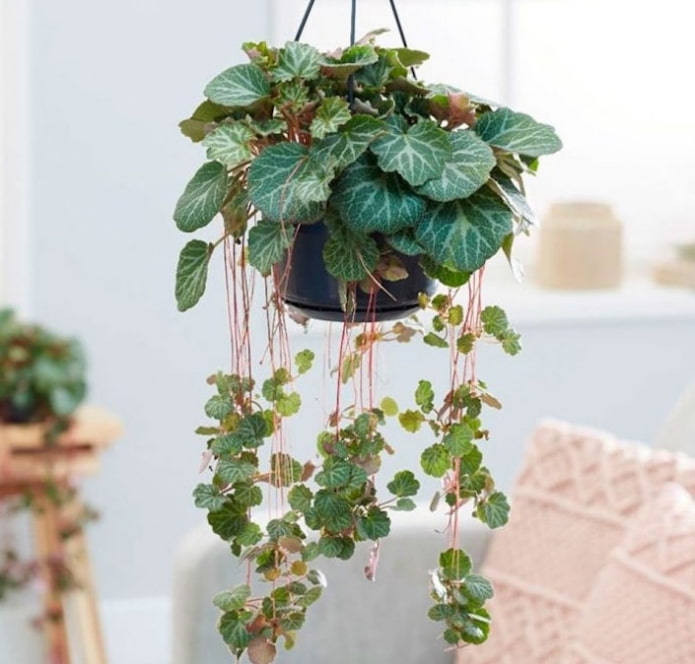
Strongylodon
It belongs to the class of lianas and belongs to the legume family. It forms a very powerful, fast-growing stem, the length of which can reach 20 m. The main distinguishing feature of the culture is the unusual flowers of turquoise shades, which are collected in a long racemose inflorescence.
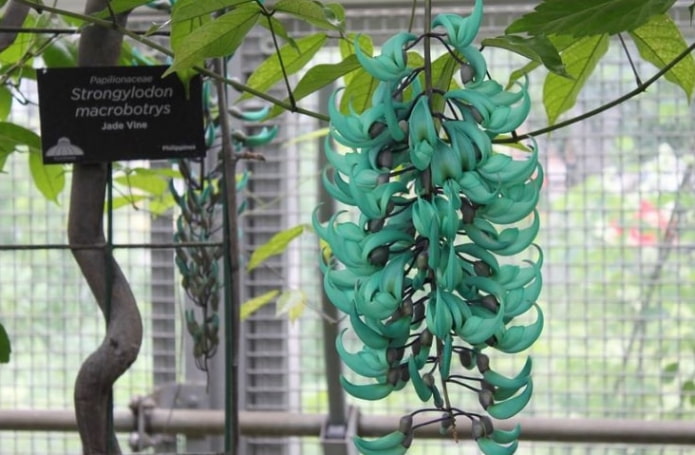
Stephanotis profusely flowering
This is a climbing liana that grows in the tropical forests of Madagascar. In a humid and warm climate it actively develops and can reach a length of 6 m. Its young stem is elastic and flexible, but over time it becomes woody.
Delicate white flowers become the main decoration, because of which Stephanotis is considered the most desired plant of flower growers all over the world. They exude a pleasant jasmine aroma, for which the liana is often called Madagascar jasmine.
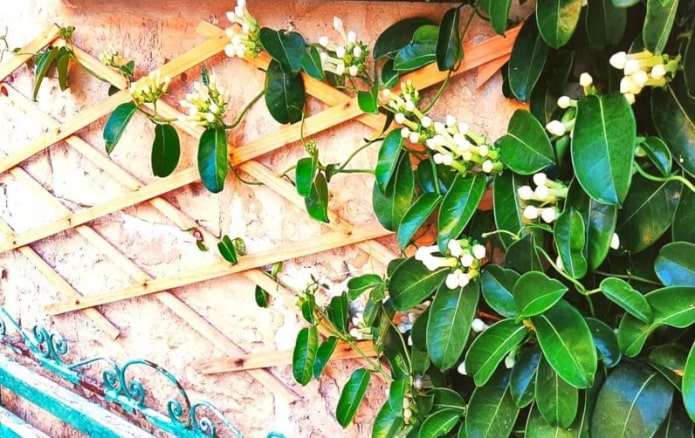
Calystegia
In the natural environment, the Calystegia liana is widespread in East Asia, mainly in Japan. It develops like all climbing plants, forming very beautiful large flowers. Calystegia is considered a weed that is difficult to get rid of, but it can be a good decoration for the interior.
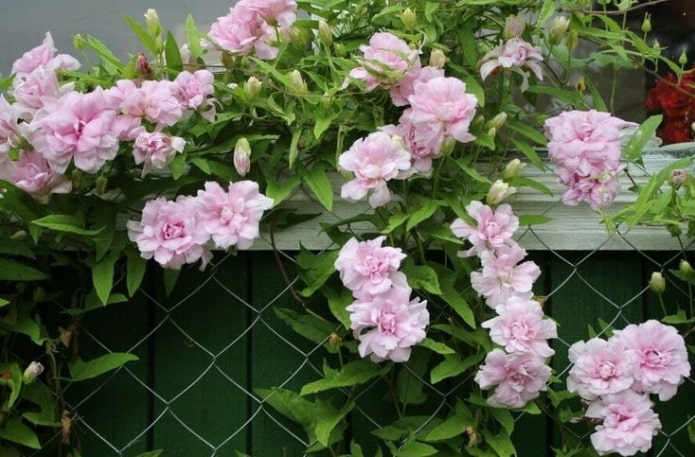
Callisia
Outwardly, callisia resembles ficus pumila, but unlike it, it has more lush foliage. The plant rarely blooms when grown indoors, but attracts attention with its bright foliage, which, depending on the variety, can be green, white, pink or multi-colored.
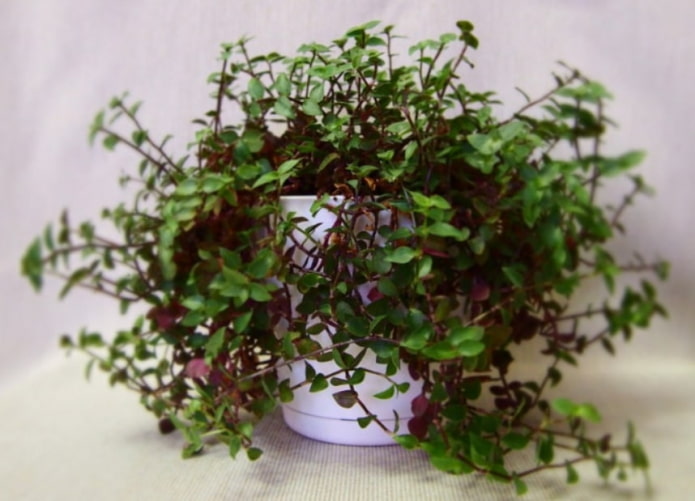
Clerodendrum
This is a liana-like plant with a lush rosette formed by large fleshy leaves. Its characteristic feature is the unusually beautiful white-red flowers, which bloom annually with proper care. Clerodendrum is easy to care for.
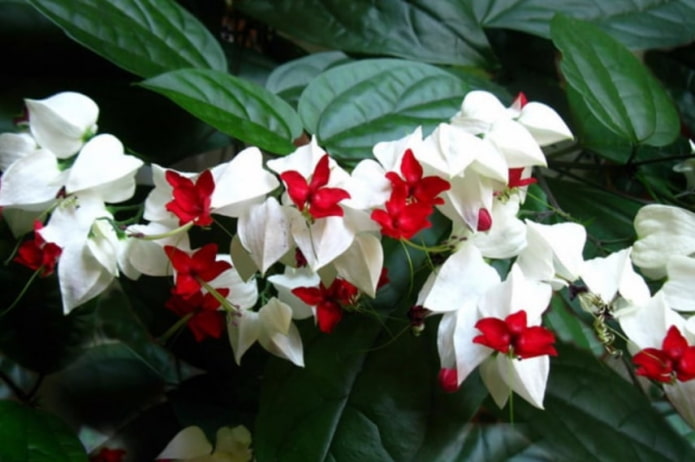
Chlorophytum vulgare
It belongs to the Asparagus family and grows in South Africa. It is naturalized in some tropical countries, including Australia and Bangladesh. It is an evergreen perennial plant with abundant leaves that hang down. It forms a branched inflorescence up to 75 cm long, on which small flowers of greenish-white shades bloom. Chlorophytum is widely used in indoor culture due to its unpretentiousness and ability to effectively purify the air.
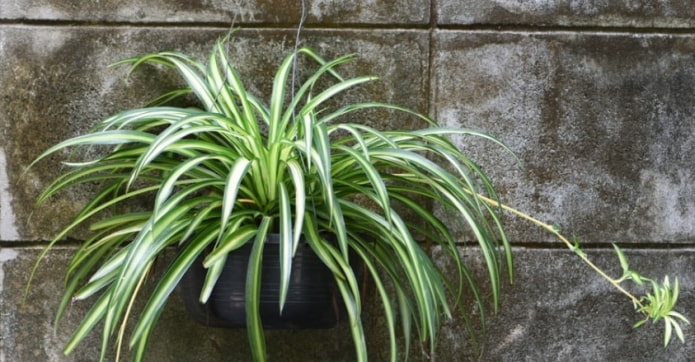
Ampelous plants for the garden
Ampels are also widely used in gardening. In this case, they are used not only for zoning space and decorating vertical surfaces, but also as an alternative to ground cover plants.
Ampelous verbena
This is a selection variety of verbena – a flowering perennial with spreading shoots. During the flowering period, large buds of bright colors bloom on it, which become a decoration of any room and garden plot. The plant is unpretentious, but prefers a lot of light and moisture.
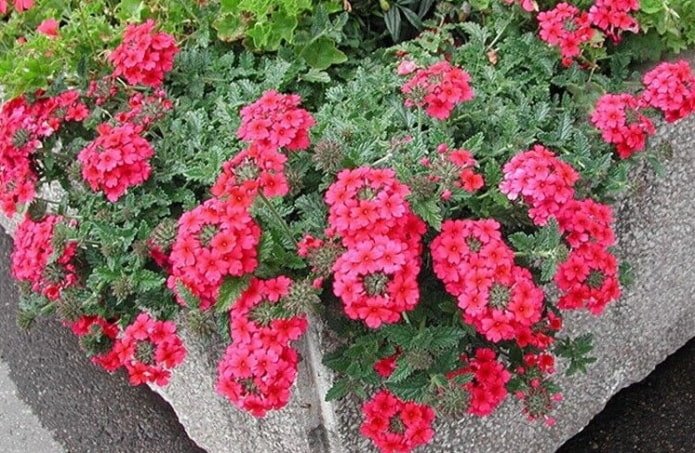
Ampelous lubelia
This is an ampelous perennial plant that forms lush, abundantly foliated bushes. During the flowering period, they produce many bell-shaped flowers of different shades.
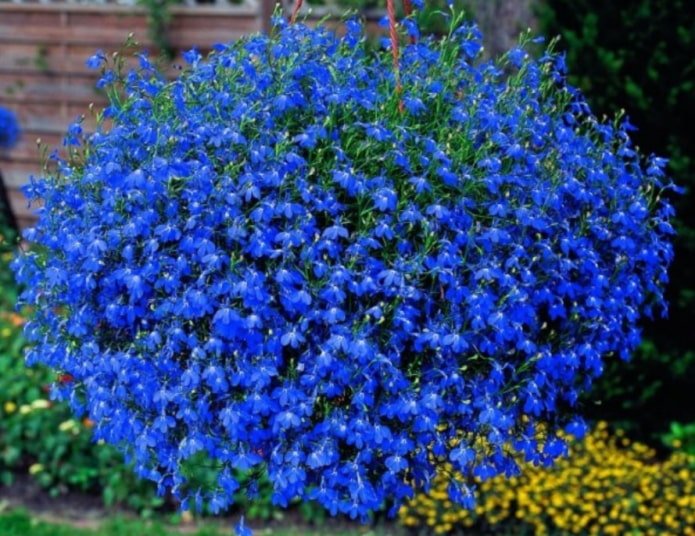
Campanula
Campanula is a flowering herbaceous plant whose stems droop under the weight of large inflorescences. They form numerous buds that bloom into 5-petal bells of various shades (from white to purple).
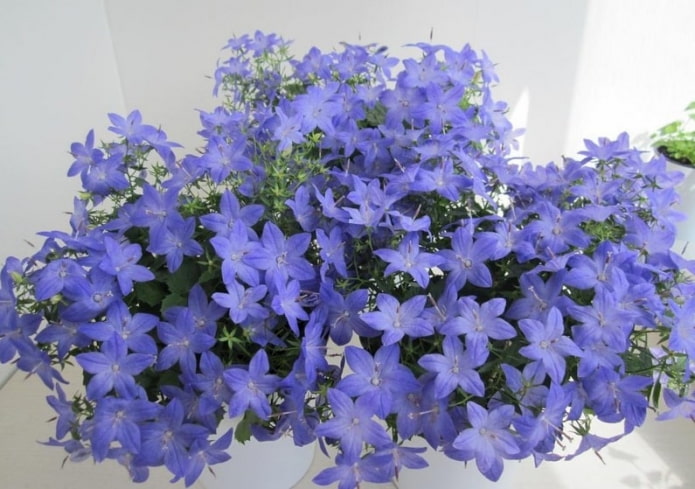
Bacopa ampelous
Bacopa originates from the forested regions of South Africa, but today it is widespread in indoor floriculture. In an artificial environment, this creeping ampelous plant is grown as a perennial, but in areas with long frosty winters it is an annual.
Bacopa forms climbing stems up to 70 cm long, covered with dark olive leaves. Several times per season, buds of various shades, from pink to purple, form and bloom on them.
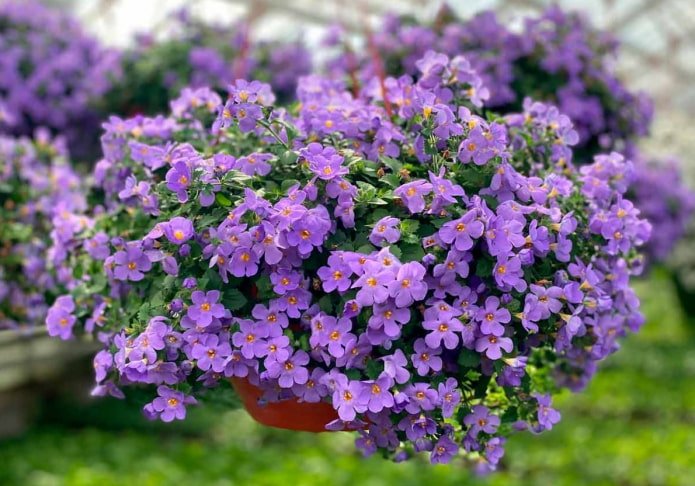
Dichondra
Dichondra ampelous is an ornamental foliage plant and is represented by several varieties, most of which belong to the class of groundcover plants. It forms many fast-growing shoots, densely covered with small yellow flowers no more than 3 mm in size each. Due to its decorative qualities, the plant is often used in flower arrangements.
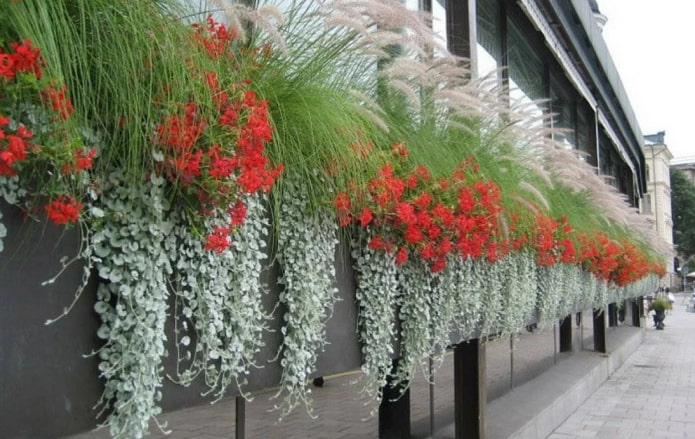
Calibrachoa
This is a flowering herbaceous plant with a lush crown that looks like a petunia. The homeland of ampel is considered to be South America, and in the indoor culture of European countries it has been known for no more than 20 years. Today, calibrachoa is valued by gardeners due to its excellent decorative qualities. It forms many densely foliated shoots on which bright bell-shaped flowers bloom.
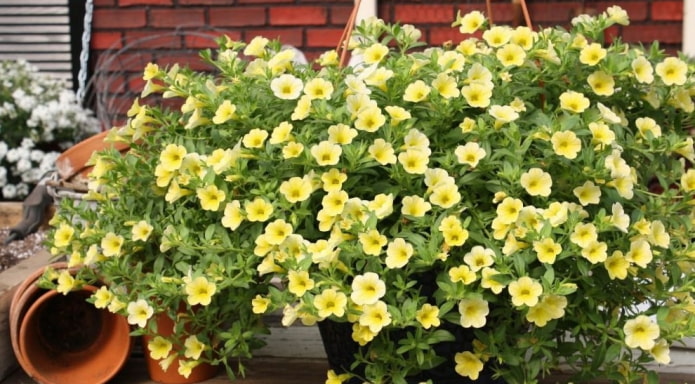
Ampel petunia
Usually petunias form erect shoots, but ampelous varieties produce long hanging stems that densely cover vertical supports. Large buds with simple, double or corrugated petals form on them. Such plants look good in a flowerpot or pot.
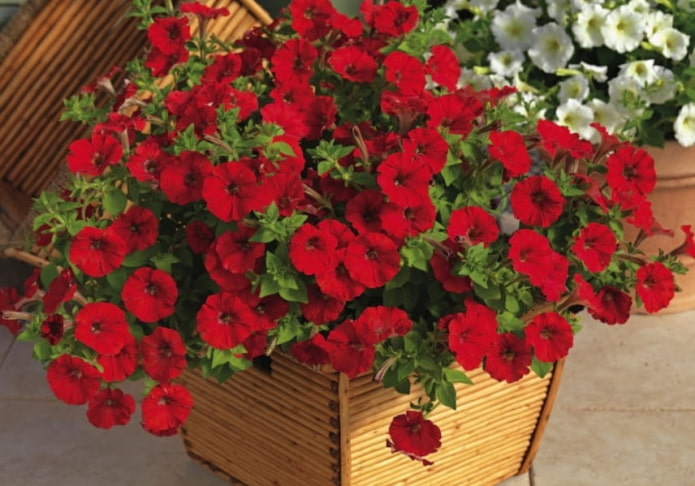
Nasturtium
This is a lush plant with multiple creeping stems. It attracts attention with its bright, dense foliage and picturesque irregularly shaped flowers.
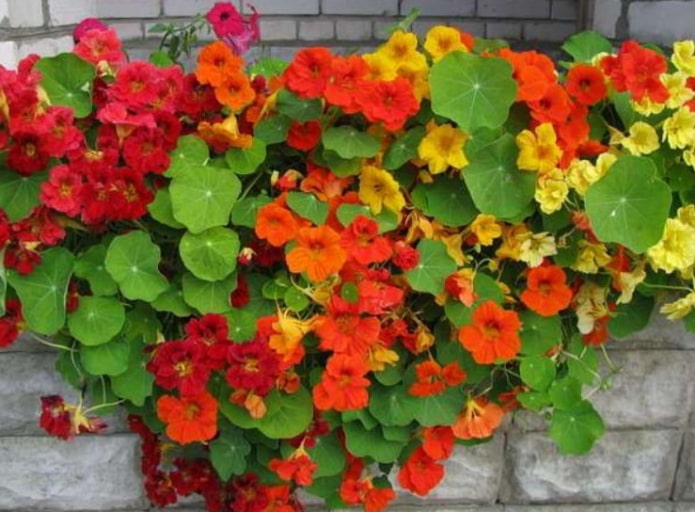
Flowering plants
There are many types of ampels that delight with long and picturesque flowering. Among them, every gardener will find something for themselves.
Ampelous begonia
It has a very dense rosette formed by pointed dark green leaves. It produces many drooping shoots on which bright picturesque flowers bloom. Caring for ampelous begonia is not easy, because it is very demanding to the temperature regime. Also, do not get carried away with frequent watering.
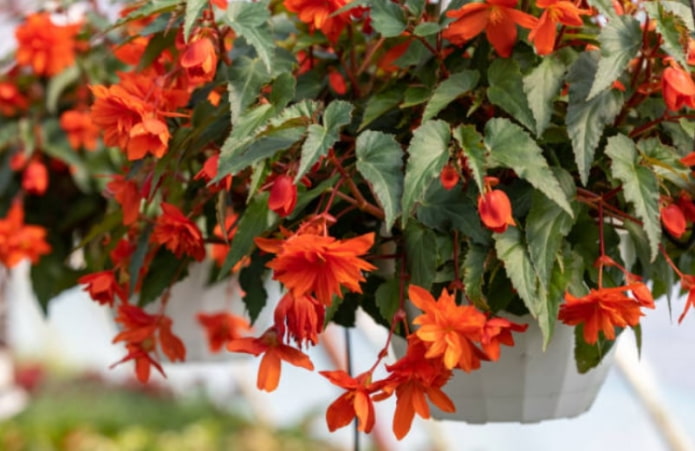
Fuchsia
The unpretentious ampelous fuchsia has unusual flowers, the bright petals of which form a “skirt” from which several thin stamens peek out. In order for it to bloom annually, it is necessary to provide a cool winter, regularly spray the foliage during the growing season and feed it with organic fertilizers.
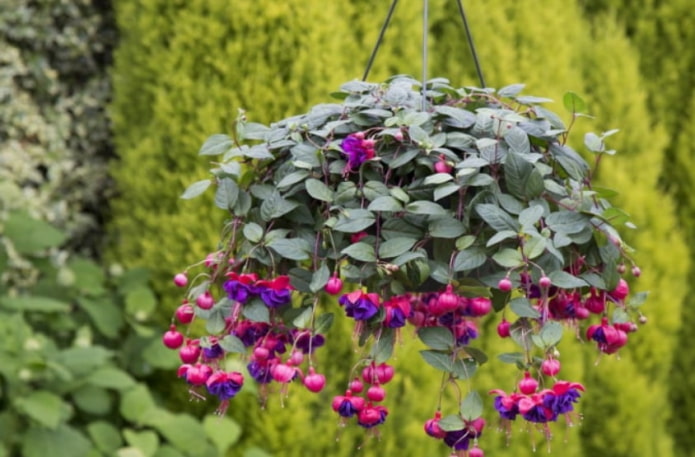
Pelargonium
One of the most beloved plants of flower growers, the popularity of which is due to its picturesque and long flowering. Ampelous varieties are especially beautiful: they release drooping shoots up to 70 cm long, covered with dark rounded leaves. On the peduncles, umbrella-shaped inflorescences of about 8 cm in size are formed, which contain an average of 30 bright buds.

Impatiens ampelous, or Balsam
This ampelous plant comes from the tropics and subtropics of Africa. It can also be grown in temperate latitudes, if you strictly follow the rules of agricultural technology. Impatiens ampelous forms many thin shoots from 20 to 50 cm in height, covered with fleshy leaves. Every year, small flowers of different shades bloom on it.
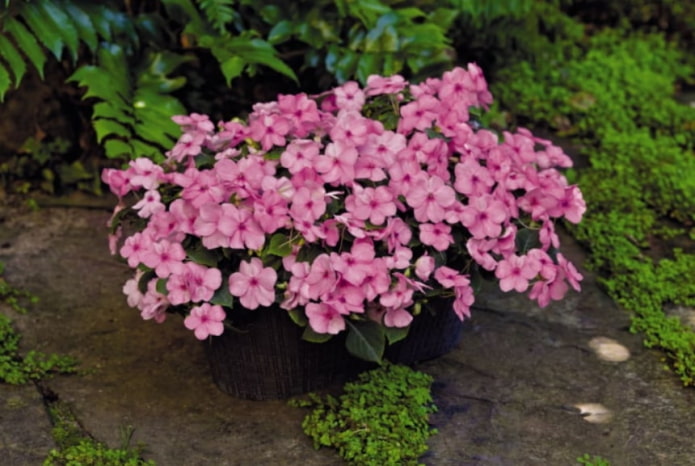
Hoya speciosa, or Wax Ivy
Hoya speciosa is one of the most beautiful ampelous plants, which attracts attention with large leaves with a waxy coating and spherical inflorescences (as in the photo). Flowers have different colors and exude an intense pleasant aroma, which intensifies at night.
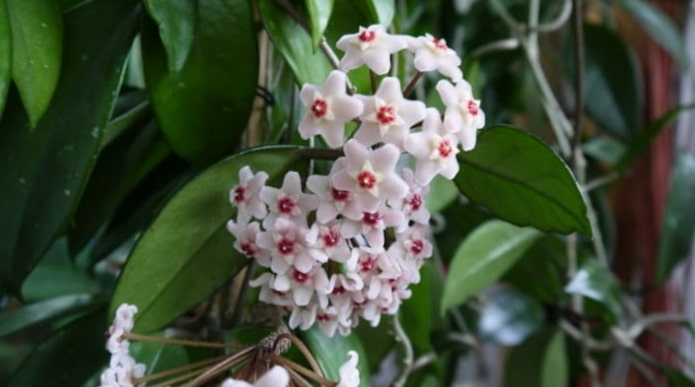
Ampelous succulents
Succulents are the most unpretentious plants. And among them there are also many ampelous varieties used for the purpose of decorating spaces.
Schlumberger, or Zygocactus truncatus
The epiphyte Schlumberger is a native of South America, where it grows in humid warm tropics. In Western culture, it is better known as the Christmas cactus because of its bright, picturesque flowers. The plant is easy to care for and produces many buds every year when grown indoors.
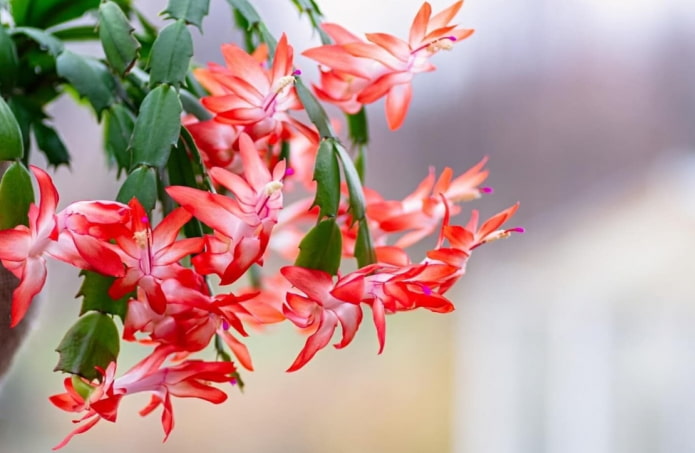
Ceropegia woodii
Forms thin creeping shoots of purple color, covered with fleshy leaves of different shapes (lanceolate, ovoid or triangular). There is a beautiful “marble” pattern on the dark green leaf blades. Small flowers with brown petals are formed in the axils. The plant has a tuber-shaped rhizome that accumulates excess moisture.
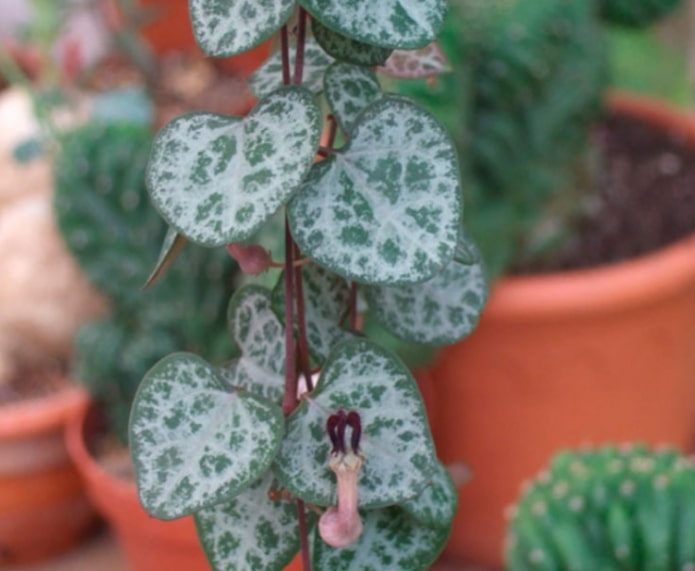
Sedum Morganii
A herbaceous succulent native to Mexico that thrives indoors. The plant forms many powerful shoots with dense leaves, in the axils of which star-shaped flowers are formed. Sedum is planted in a hanging pot and requires minimal care.
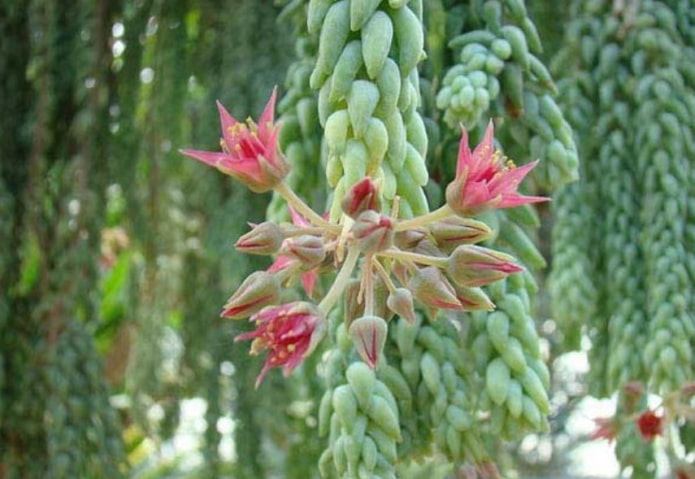
Crassula rockiana
This is a succulent with creeping shoots up to 50 cm long, covered with thick, pointed leaves arranged in pairs. In summer, small yellowish flowers bloom on it.
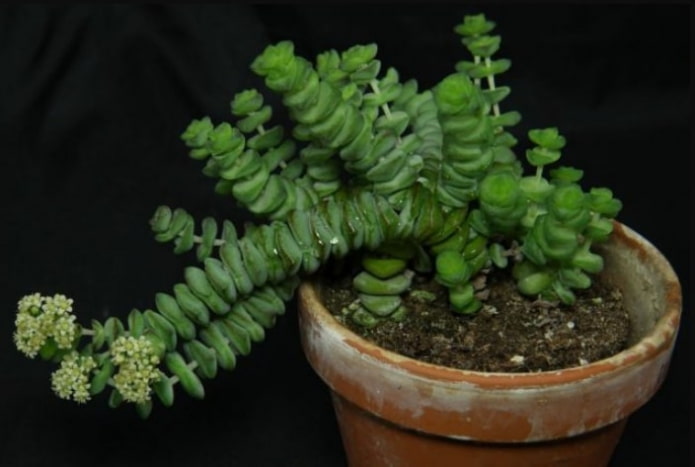
Rowleyan Senecio
This is one of the most recognizable ampelous succulents. It is distinguished by graceful thread-like hanging shoots from 60 to 100 cm in height, covered with spherical leaves (as in the photo), which look very unusual. As it develops, it becomes more lush and spectacular, for which it is especially loved by flower growers.
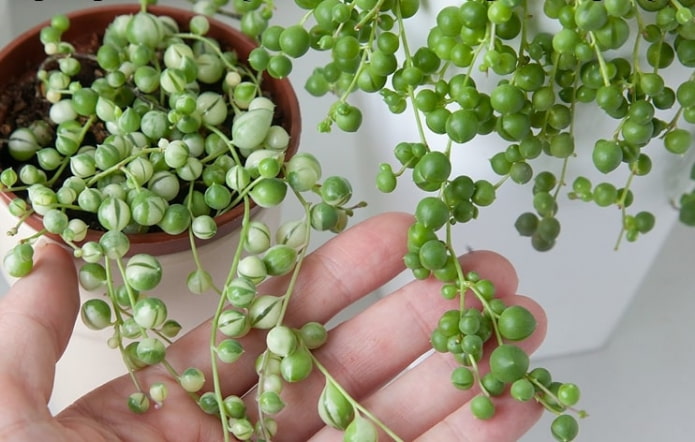
Plants with unusual leaves
Ampel species often have leaves with unusual shapes. Many of them are striking and truly mesmerizing.
Tradescantia
Tradescantia is an evergreen liana with small and inconspicuous flowers. However, it is widely distributed in culture due to its diverse variegated leaves, which, depending on the variety, acquire unusual shades and original shapes.
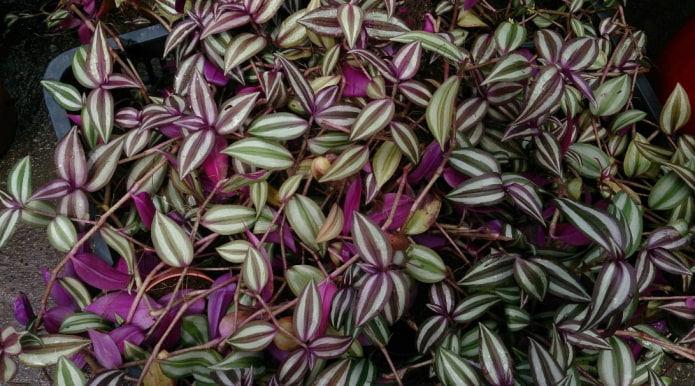
Common ivy
A popular evergreen liana, common mainly in the lowlands, foothills and deciduous forests of Europe and Asia. It is also found on the Black Sea coast of Russia. It is distinguished by very strong climbing stems that climb up supports with the help of multiple aerial roots. They are covered with carved dark green edged leaves.
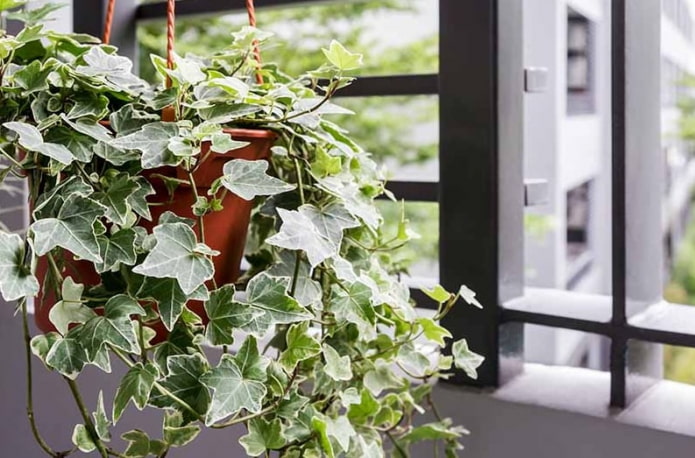
Asparagus aethiopica, or Asparagus sprengerii
A type of asparagus. Its homeland is considered to be the tropical regions of Africa, but today it is often found among indoor crops. The plant forms multiple shoots, hanging down, which with proper care they can reach a length of 150 cm. They have rare needle-shaped leaves 3 cm long and only 1-2 mm wide.
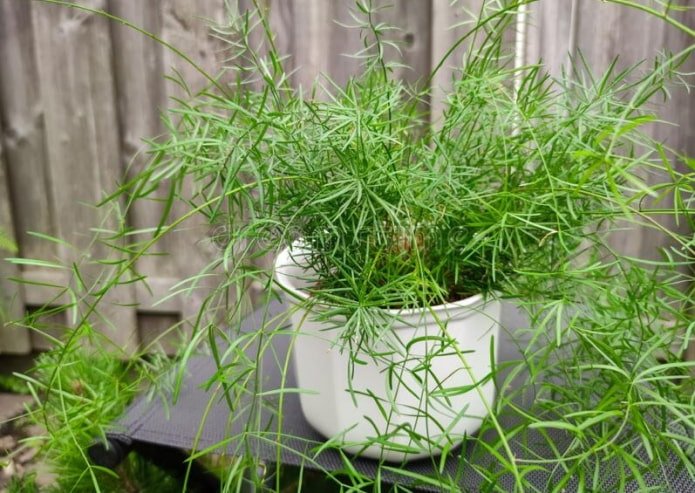
Creeping dichondra
It is considered a close relative of such picturesque ampelous plants as calystegia and morning glory. Its natural habitat is the tropics and subtropics of New Zealand, Australia, Asia.
The plant forms multiple creeping shoots, strewn with small rounded leaves. The leaf blades have a rich green color with an unusual silvery coating (as in the photo), which attracts attention no less than any flowers.
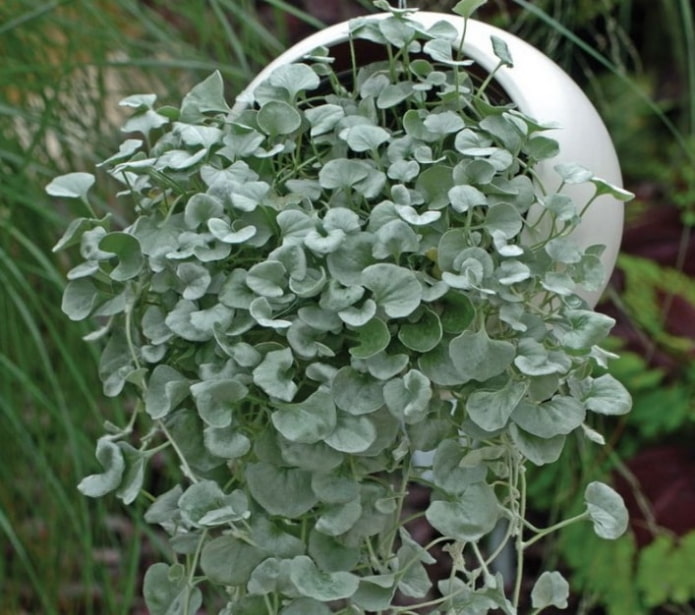
Monstera oblique
Monstera oblique is a tropical semi-epiphyte native to Central and South America. The plant can live on tree trunks and the ground at the same time. Its name comes from the Latin word “monstrum”, which means “anomalous”. The semi-epiphyte received this name due to its perforated leaves (as in the photo), each of which has larger holes.
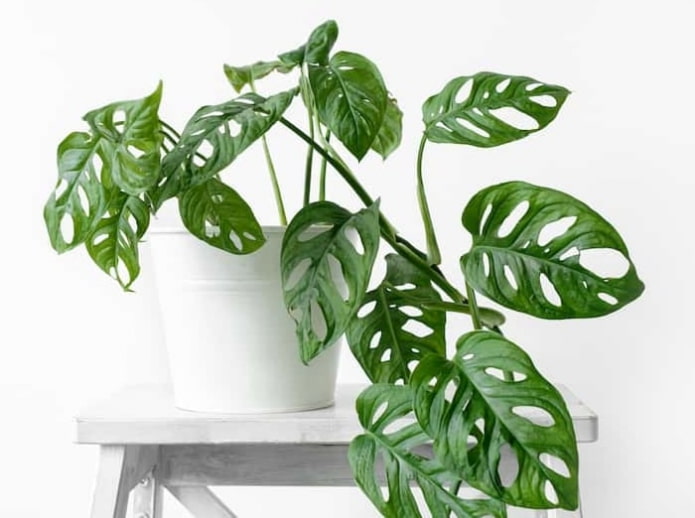
Growing Features
Ampelous plants are generally unpretentious and require minimal attention. However, for their normal development and flowering, it is necessary to follow several rules.
- Choosing a container and planting. First of all, it is important to choose the right container, and if necessary, support. Ampelous plants with drooping and creeping leaves are planted in pots and flowerpots, taking into account how much they can grow during their life cycle. For example, Ficus Pumila is a dwarf plant and feels good in a small hanging pot. On the contrary, strongylodons form powerful stems up to 20 m long and gradually lignify, so they need a stronger pot and support. The required amount of soil is poured into the container and 1 plant is planted.
- Reproduction. For the purpose of propagation of ampels, seeds, cuttings, shoots are used. The latter method is more effective, since in this case the plants are less likely to get sick and bloom profusely. Seeds are sown in early spring. In order for the grains to germinate faster, at the first stage they are placed in a mini-greenhouse, and after 1-2 weeks shoots appear. As soon as 2 leaves appear on the young shoots, they are transplanted into a container. Before planting, the cuttings are rooted. They are placed in water for several days and after the roots appear, they are transplanted into the soil.
- Formation of the plant. In order for the ampel to acquire a classic shape, you need to devote some time to the formation of shoots. The very first stems should be pinched (or cut), then the plant will begin to bush out. Then, over the course of several weeks, you need to monitor so that the shoots acquire approximately the same length.
Basic care rules
In order for the ampel to develop correctly and intensively, you need to provide certain conditions:
- Regularly water and spray. Basically, ampel needs moderate watering: once every 1-3 days during the growing season. During the dormant period, moisten the soil every 2-3 weeks, or as it dries out. But it should be remembered that some species need more abundant or scanty watering.
- Choose the best temperature regime. Most ampels are tropical plants that develop better at +20…+22°C in summer and +14…+16°C in winter.
- Optimize lighting. Ampelous plants prefer a lot of light and tolerate exposure to direct sunlight well. But among them there are also shade-loving species.
If the ampel is developing poorly and does not bloom, then it is fed with a universal fertilizer, which contains nitrogen, phosphorus, potassium in equal parts and 1/4 ammonium nitrate in total. The mixture is dissolved in water at the rate of 100 g per 10 l and the plant is watered weekly in the required amount.